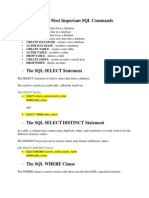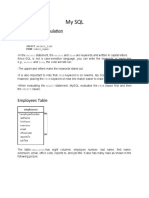0% found this document useful (0 votes)
74 views9 pagesSQL Basics for Beginners
The document provides examples and explanations of common SQL commands and clauses including SELECT, WHERE, ORDER BY, INSERT, UPDATE and NULL values. Key points covered include how to select, filter, sort, insert and update data in a database table. Examples are provided for each concept to demonstrate their usage.
Uploaded by
douds95Copyright
© © All Rights Reserved
We take content rights seriously. If you suspect this is your content, claim it here.
Available Formats
Download as DOCX, PDF, TXT or read online on Scribd
0% found this document useful (0 votes)
74 views9 pagesSQL Basics for Beginners
The document provides examples and explanations of common SQL commands and clauses including SELECT, WHERE, ORDER BY, INSERT, UPDATE and NULL values. Key points covered include how to select, filter, sort, insert and update data in a database table. Examples are provided for each concept to demonstrate their usage.
Uploaded by
douds95Copyright
© © All Rights Reserved
We take content rights seriously. If you suspect this is your content, claim it here.
Available Formats
Download as DOCX, PDF, TXT or read online on Scribd
/ 9





















































































